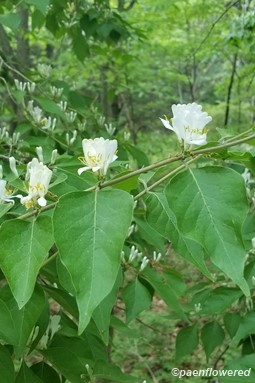Lonicera maackii
Invasive alien shrub that has become part of forest understory in most of eastern US
Lonicera maackii amur honeysuckle
This is another Asian invasive shrub that has escaped cultivation and is now widespread in the forest understory of eastern United States. It is native to the Amur River Valley between the Russian Far East and Manchuria in China. It is one of four species of Asian honeysuckle that is now growing in the United States.
It is a deciduous large shrub with ascending and arching branches that can grow 18-20 feet tall and have stems up to four inches in diameter. The bark is distinctively ridgy. The leaves are oppositely arranged on the stem. They are about 1 ½ to 2 ½ inches wide and have a smooth margin. The attractive, fragrant white flowers are produced in spring or early summer and turn yellowish with age. The berries mature in the fall and are bright red to black and semi-translucent. Birds readily eat the fruit and disperse the seeds.
The amur honeysuckle grows well in the shade of the forest but will also grow in neglected urban areas and fence rows. It can form thickets that can be extremely dense and shade out or inhibit the growth of native shrubs and herbs.
Habitat & Range
Grows in man-disturbed habitats, roadsides, and forest edges.
Present throughout the state.
Range: Throughout Eastern United States.
Wetland code: Not classified
Phenology
Flowers late May to early June.
Fruits October & November.




.jpg?v=638120063270000000)







Comments
Have you spotted this plant in your area? We'd love to hear about your experience! Share your comments or questions about the plant below. Comments are moderated before posting.